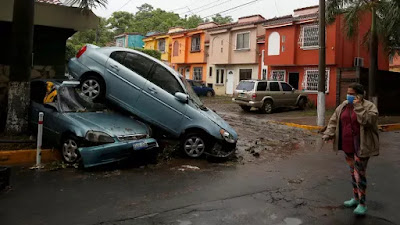At least eighteen people have died and several more are missing after Tropical Storm Amanda made landfall on the Pacific Coast of El Salvador on Sunday 31 May 2020, bringing with it over 500 mm of rain in twenty four hours. The majority of the fatalities occurred in El Salvador, where fifteen people are known to have died, including a family of three who died when their home was swept away by a landslide in San Juan Opico. Landslides are a common problem after severe weather events, as excess
pore water pressure can overcome cohesion in soil and sediments,
allowing them to flow like liquids. Approximately 90% of all landslides
are caused by heavy rainfall. Another two people died in Guatemala, including a a nine-year-old-boy swept away by a flash flood and another person killed in a house collapse, and one person has lost their life in Honduras, which has also suffered a series of landslips and flood events.
Damage caused by Tropical Storm Amanda in San Salvador, the capital city of El Salvador, on 31 May 2020. Jose Cabezas/Reuters.
Tropical
storms are caused by solar energy heating the air above the oceans,
which causes the air to rise leading to an inrush of air. If this
happens over a large enough area the inrushing air will start to
circulate, as the rotation of the Earth causes the winds closer to the
equator to move eastwards compared to those further away (the Coriolis
Effect). This leads to tropical storms rotating clockwise in the
southern hemisphere and anticlockwise in the northern hemisphere. These
storms tend to grow in strength as they move across the ocean and lose
it as they pass over land (this is not completely true: many tropical
storms peter out without reaching land due to wider atmospheric
patterns), since the land tends to absorb solar energy while the sea
reflects it.
A landslide caused by Tropical Storm Amanda in El Salvador on 31 May 2020. Yuri Cortez/AFP.
Despite the obvious danger of winds of this speed, which can physically
blow people, and other large objects, away as well as damaging buildings
and uprooting trees, the real danger from these storms comes from the
flooding they bring. Each drop millibar drop in air-pressure leads to an
approximate 1 cm rise in sea level, with big tropical storms capable of
causing a storm surge of several meters. This is always accompanied by
heavy rainfall, since warm air over the ocean leads to evaporation of
sea water, which is then carried with the storm. These combined often
lead to catastrophic flooding in areas hit by tropical storms.
Floodwaters on the River Los Esclavos in Guatemala on 31 May 2020. Moises Castillo/AP.
See also...
Follow Sciency Thoughts on Facebook.









